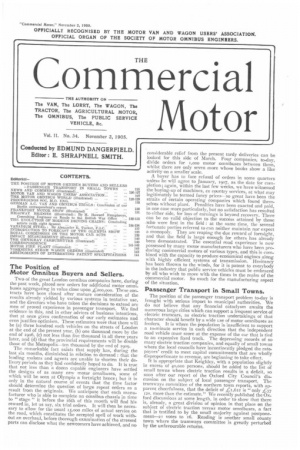The Position of Motor Omnibus Buyers and Sellers.
Page 1

If you've noticed an error in this article please click here to report it so we can fix it.
Two of the great London omnibus companies have, during the past week, placed new orders for additional motor omnibuses aggregating in value close upon ,4'200,000. These contracts have been closed after mature consideration of the results already yielded by various systems in tentative use, and the directors who have taken the decisions to extend are men of proved experience in passenger transport. We find evidence in this, and in other advices of business intentions, that at once gives confirmation of our early estimates and even justifies optimism. These estimates were that there will be (a) three hundred such vehicles on the streets of London at the end of the present year, (b) one thousand more by the end of 1906, (c) not less than five thousand in all three years later, and (d) that the provincial requirements will be double those of the Metropolis—ten thousand by the end of Ionia. The remarkable fact e.xists that supply has, during the last six months, diminished in relation to demand : that the leading makers and agents are unable to shorten their delivery periods as they had confidently hoped to do. It is true that not less than a dozen capable engineers have settled the designs of as many new motor omnibuses, some of which will be seen at Olympia a fortnight hence ; but it is only in the natural course of events that the time factor should determine the question of large repeat orders as a result from the originals. We anticipate that each manufacturer who is able to complete an omnibus chassis in time to " stage " it before the f 6th of this month will find his reward in, let us say, six trial orders. It will then be necessary to allow for the usual 15,000 miles of actual service on the road, which constitutes the accepted spell of work without an overhaul, before thorough examination of the stressed parts can disclose what the newcomers have achieved, and no considerable relief from the present tardy deliveries can be looked for this side of March. Four companies, to-day, divide orders for i,000 motor omnibuses between them, whilst there are only seven more whose books show a like activity on a smaller scale.
A buyer has to face refusal of orders in some quarters .unless he will agree to January, 1907, as the date for completion ; again, within the last few weeks, we have witnessed the buying-up of machines, ex country services, at what may legitimately he termed fancy pricesso great have been the straits of certain operating companies which found themselves without plant. Penalties have been exacted and paid, in one case more particularly, but no satisfaction has resulted to either side, for loss of earnings is beyond recovery. There can be no valid objection to the success attained by those who were first in the field : at the same time, the several. fortunate parties referred to can neither maintain nor expect a monopoly. They are reaping the due reward of foresight, and that the field is large enough for others has already been demonstrated. The essential road experience is now possessed by many motor manufacturers who have been producing commercial motors of various types, and this is combined with the capacity to produce economical engines along with highly efficient systems of transmission. Hesitancy has been thrown to the winds, for it is patent to everybody in the industry that public service vehicles must be embraced by all who wish to move with the times in the realm of the commercial motor. So much for the manufacturing aspect of the situation.
Passenger Transport in Small Towns.
The position of the passenger transport problem to-day is fraught with serious import to municipal authorities. We do not believe that any financial cataclysm awaits the numerous large cities which can support a frequent service of electric tramcars, as electric traction undertakings of that character should benefit by a wide Ilse of motor omnibuses as feeders. It is where the population is insufficient to support a to-minute service in each direction that the independent road vehicle must score at the expense of the car that is tied to an expensive fixed track. The depressing records of so many electric traction companies, and equally of small towns where the local councils have incontinently pledged the ratepayers' credit to meet capital commitments that are wholly disproportionate to revenue, are beginning to take effect.
It is appropriate that Keighley, with a population slightly in excess of 40,000 persons, should be added to the list of small towns where electric traction results in a deficit, so soon after our report of the Oxford City Council's discussion on the subject of local passenger transport. The tramways committee of the northern town reports, with apparent cheerfulness, that the deficit of £1,612 is "only .4;37 125, more than the estimate." We recently published the Oxford discussions at some length, in order to show that there is, already, a great division of opinion in that place on the subject of electric traction versus motor omnibuses, a fact that is testified to by the small majority against postponement-2 r votes to 16. Reading is another small county town where the tramways committee is greatly perturbed by the unfavourable returns.






















